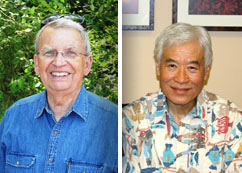
Photos and text used with permission of
David Houchens and Paul Mizue.
When David Houchens and Paul Mizue were diagnosed with prostate cancer, they chose different treatment options. David underwent radical open prostatectomy followed by hormone ablation and radiation treatments, while Paul chose proton beam therapy. One area of agreement between them is a shared desire to help scientists and researchers cure prostate cancer for all men.
After his diagnosis but before his treatment, Paul was urged to attend a meeting of Us TOO, an international prostate cancer education and support organization. What he learned helped him, and continues to help him, through his post treatment. Perhaps more significantly, it led him to explore ways of helping men faced with the same scenario he had experienced.
“There is a tremendous lack of information, and perhaps excessive trust in doctors, for many men to make a decision in their best interest,” Paul said. “Although I do not have a history as a volunteer, I believe [that even] in my limited capacity, if I can provide good information to other men afflicted with prostate cancer, my service will be worthwhile.”
Another Us TOO volunteer introduced Paul to the Department of Defense Prostate Cancer Research
Program (PCRP). At his friend’s suggestion, Paul applied to be a peer reviewer for the PCRP, and was selected to take part in 2011.
As a mentor reviewer and strong believer in the value of an experienced reviewer guiding and supporting someone new, David was paired with Paul to help him understand the process.
“There are definitely differences between being a novice reviewer and a mentor,” David said. “The most important lesson that a novice reviewer can learn is that they are serving as a consumer reviewer and thus will be asked to address the question of how a specific project would impact the prostate cancer community assuming that the project will be successful.”
For his part, Paul said that having David as a sounding board and supporter helped not only during the peer reviews, but before they took place.
“When I did have a question, such as the actual criteria I was to evaluate, David was an invaluable source of information,” Paul said. “He recommended that I look only at the Clinical Impact measure, although I was free to look at other evaluation factors.” As a non-scientist on the panel –and knowing that his mentor, David, was not only a prostate cancer survivor but also a scientist with a Ph.D. – Paul admitted to feeling somewhat intimidated. But the guidance he received from discussions with David, webinars provided by the Congressionally Directed Medical Research Programs (CDMRP), and other sources of information helped him understand and appreciate his consumer role.
Recalling his days as a novice reviewer, David said he understood and appreciated Paul’s concerns.
“The most challenging aspect for a consumer reviewer is to overcome the uncertainty of how to prepare a review that they can share with the scientific reviewers on the panel,” David said. “I think that many novice reviewers assume that they must be able to fully understand the science in a given proposal and they become frustrated when they cannot understand it. By focusing on the potential impact of a proposed project and explaining what such a project would mean to the prostate cancer patients, they can help the scientists on the panel better understand the potential patient-related benefits or drawbacks of the project.”
The opportunity to take his advocacy efforts to a new level and learning about potential breakthroughs in science were more than enough to keep Paul’s interest.
“When I go to Us TOO meetings, I provide direct information to others on what I know about the need for proper medical information and being one’s own health advocate,” Paul said. “The opportunity to be a peer reviewer enabled me to keep abreast of new developments in prostate cancer, while at the same time doing something beneficial for medical research.”
Last updated Thursday, May 26, 2022














